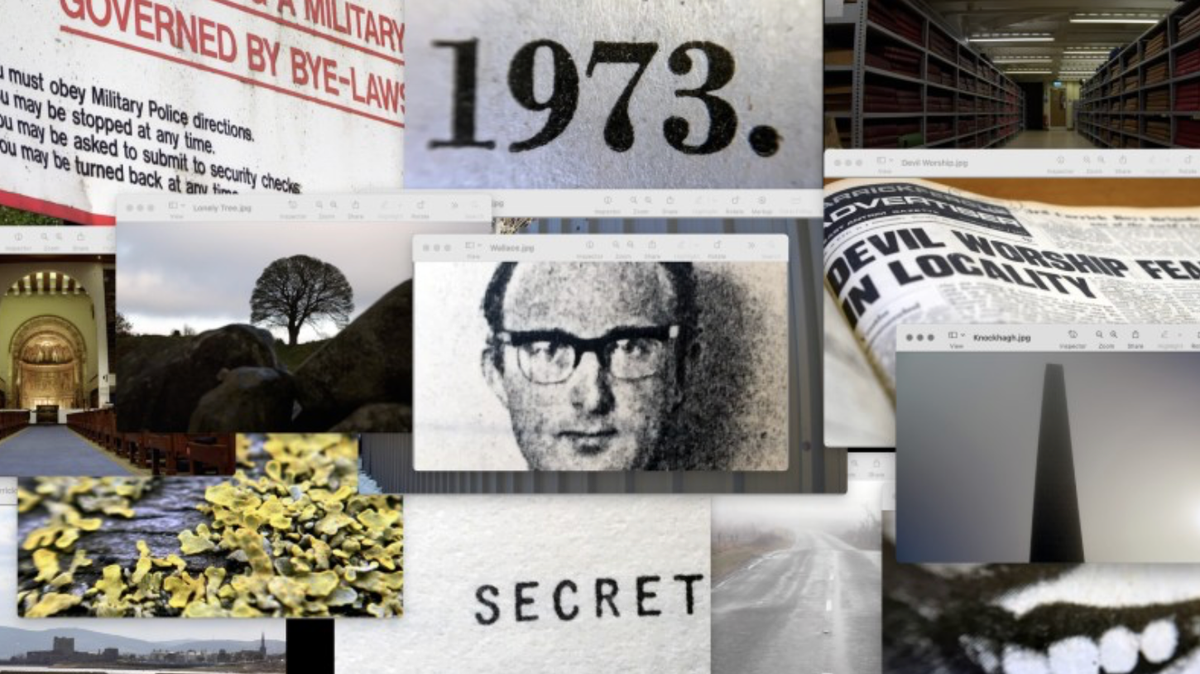Rena McGauley lifts the lid on the spectres of state secrecy with her review of Operation Boogeyman at Docs Ireland.
The ghosts of the past are a familiar haunt of Northern Irish cinema and culture, so much so that the phrase “ghosts of the Troubles” has seeped into cliché. Ghosts take on a double entendre in Operation Boogeyman, as socio-historical memory contends with the prevalence of psyops and misinformation in 1970s Northern Ireland. Starting with his native Carrickfergus, filmmaker Simon Aleppi weaves together folklore, family history and a shared memory of a grim past.
The screening in Queen's Film Theatre Belfast was followed by an audience Q&A, with many questions framed around attendees' own personal or familial experience with Troubles-era spectres and fear of the satanic in towns and villages across the land. Understanding the Troubles, even for people like myself who were born post-Good Friday Agreement, is often through half-whispered stories and disputed facts. In holding a candle up to an absurd piece of 1970s propaganda, Operation Boogeyman questions what else is hiding behind the curtain of state secrecy in Northern Ireland.
Operation Boogeyman’s hook is an investigation into the “black propaganda” concocted by British “information officers” in the 1970s. Spearheaded by Colin Wallace, a man with a life so eventful it justifies several films of its own, Operation Boogeyman was an artful precursor to “Satanic Panic” that set out to connect the IRA and the occult in the minds of the Catholic population.
Wallace’s career as a British Army “information officer” forms much of the film's middle narrative, with Wallace’s tactics of manipulation and distraction feeling both absurd and uncomfortably familiar. In a combination of interviews with those who knew him and Wallace himself, Operation Boogeyman paints a picture of a man intent on sowing the seeds of doubt into every interaction. Former co-workers describe Wallace as constantly making implications and comments designed to steer their opinions on public figures and politicians.
Despite seemingly friendly onscreen interactions, Aleppi, in person at the event, stated to the audience that he was never really sure when Wallace was telling him the truth. While this film contains Wallace’s story in relation to his involvement in Operation Boogeyman, it should be noted that Wallace’s own later life was marred by conspiracy as an alleged whistleblower for the Kincora Boys’ Home sexual abuse scandal. While this is not discussed onscreen, the prevalence of that story in local media makes Wallace a particularly difficult figure to pin down.
Filmmaker Simon Aleppi chose to fund Operation Boogeyman through a PhD, with the film's form stylised as a digital deep dive. Much of what we see is through Google Maps, Street View, or newspaper clippings with time to only glimpse flashes of the headlines. This collaged delivery feels both distant and suffocating, with the information delivered overwhelming but incomplete. Carrickfergus, Aleppi’s hometown, acts as the film's geographical and narrative centrepiece. Much of Wallace’s psychological operations surrounding the occult focused on rural Mid-East Antrim in populations made suggestible through isolation and deep roots with oral tradition.
Aleppi connects the machinations of British intelligence with Ireland’s history with folklore and so-called “black magic”, with the last Irish witch burnings taking place in Carrickfergus itself, as well as the folk horror cinematic landscape of the 70s. This is one of the film's major implications: that popular media’s obsession with the occult was not just an explicit manipulation but an act of “filling in the blanks” in the minds of a society riddled with censorship.
Propaganda is undoubtedly the cornerstone of the film, becoming almost comical in Wallace’s own descriptions of British intelligence officers gallivanting around Catholic areas in wigs and robes, brandishing black candles. The sensationalism of such an image is appealing, if not completely ridiculous, perhaps lending credence to its effectiveness as a propaganda set piece. If you come away from this film seeing it as just a bizarre time capsule, some of the more distressing and material consequences of misinformation may be lost on us.
Both Wallace and Aleppi now coincidentally reside in Farnham, a military town around 58 km southwest of London. Through both its population of personnel and the 1974 bombing in nearby Guildford, this quiet town is deeply connected to the violence of the Troubles.
During the discussion that followed, many of the attendees' questions were framed around their own runs ins with fear of the satanic in towns and villages across the land. Onscreen, Wallace himself concludes that his psychological operation took on “a life of its own”. Wallace opened Pandora's box, seeking to grab both Ireland’s past through figures like the banshee and its socio-political future without realising how deep-set hauntology features in Northern Irish society.
An interesting consequence of the documentary's subject matter is an awareness of both our and the filmmaker’s limitations. Rather than a criticism, I mean this as an acknowledgment of the impossibility of a satisfying conclusion on such a contentious topic and history. I walked away from the film equal parts frustrated and intrigued. Filmmakers and audiences fall down rabbit hole after rabbit hole, and as we seem to be edging upon a revelation we are invariably met with scores of redacted documents or inconsistent stories.
Aleppi’s narration often feels like it’s winking at the audience: “well this is what they SAY happened”. Even Wallace, arguably the documentary's secondary protagonist after Aleppi himself, is described as a “professional liar”. The 1970s were half a century ago, and if we seek to replay this era we are largely relying on narrators we know are unreliable.
Operation Boogeyman is less of a ghost hunt than an exorcism of moss-ridden landscapes and half-forgotten tales. The film opens in the modern Titanic Quarter in the shadow of green screens and multi-million-pound developments, and by the film's conclusion we are clicking through Google satellite images of a military archive redacted from both filmmaker and audience. Is progress really progress if it requires truth to be buried? No ghost or spectre conjured in the film will ever be as spine-chilling as the never-ending collective reckoning in the absence of transparency.
Operation Boogeyman screened in Queen's Film Theatre at Docs Ireland on 24th June 2025.

